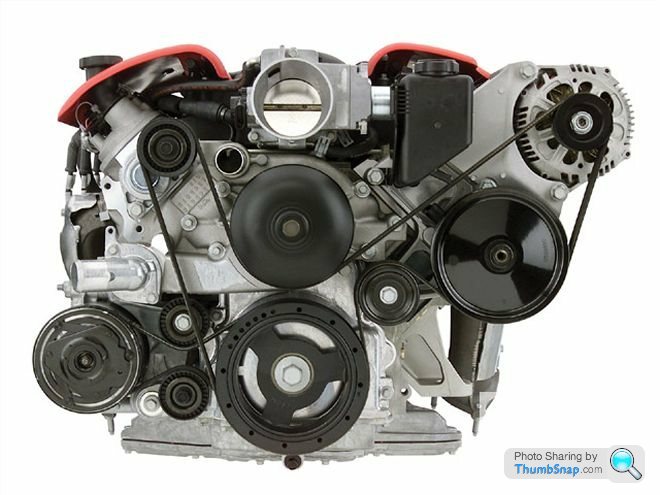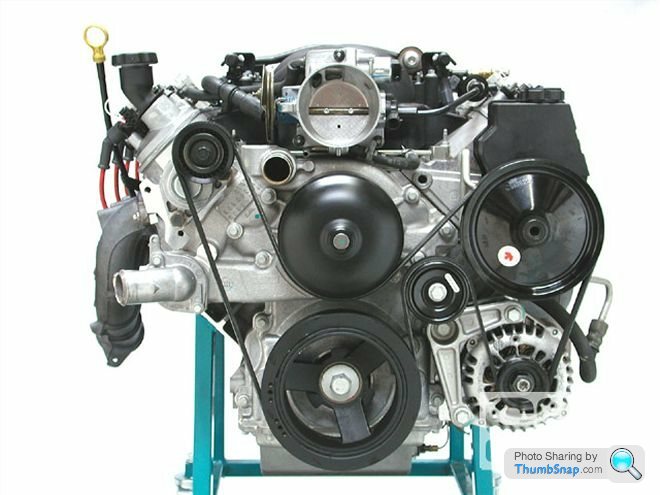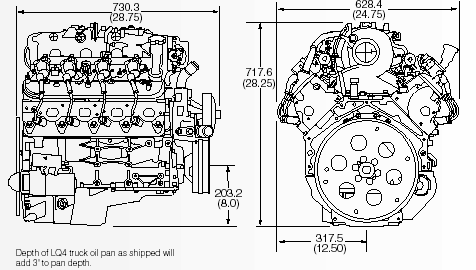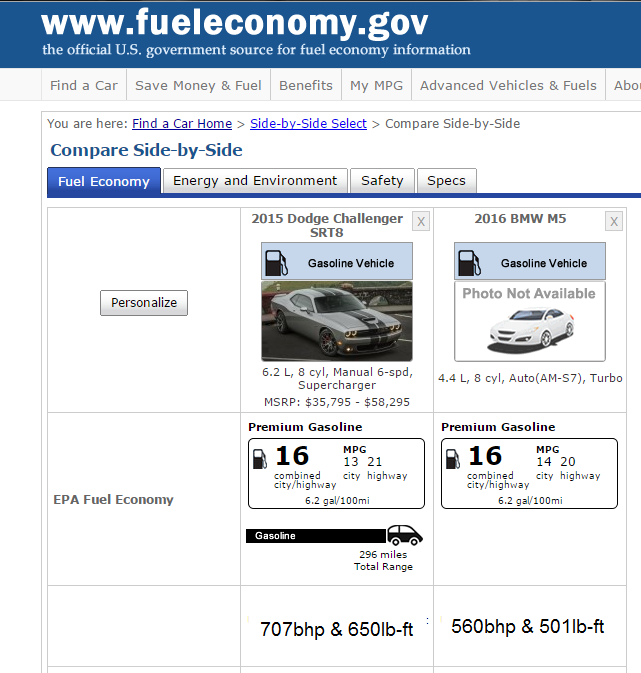Potentially Stupid Question - Overhead Cam Engines
Discussion
lostkiwi said:
Pushrod inline engines are still very common in industrial diesels (6 litres and above) - even those complying with the latest euro emissions regulations.
Pretty much universal in boats, I think - I guess any application where long-term reliability and ease of maintenance is important and any lack of power can simply be remedied by making things bigger. Of course diesel powered boats tend to generate peak power at about 600rpm or less, which makes accurate valve control rather less important. 
kambites said:
What I think many people argue is that it wont rev or make power whilst with the same configuration returning decent economy when driven gently.
That's probably not true, but it's certainly the argument you see used.
Although power comes from burning fuel, so reciprocating/rotating mass notwithstanding, doesn't matter what displacement the engine is. Most LS-equipped cars run a T56 or TR6060 6-speed transmission which will return a 70 mph cruise at approx 1500 rpm. That enables them to return about 28-30 mpg. Of course, boot it and use all the power on tap and you are talking single figures but that's the same of any engine pulling a similar weight, delivering the same performance.That's probably not true, but it's certainly the argument you see used.
wormus said:
My 6.2 LSA revs to 7000 rpm and makes 133hp litre. Ok, it has FI but to say it won't rev or make power because of its valve train configuration is just not true.
Quite. That was a rather silly claim for someone to make. In fact my 5.4 german engine "only" has 129bhp/litre and gets out of breath at 6800rpm, however it does have SOHC so apparently it's vastly superior to your yank junk 
V8RX7 said:
300bhp/ton said:
Who frankly gives a flying smeg about bhp/litre.
It's total power output that matters. And 450bhp beats anything 200-250bhp.
Everyone in a race series.It's total power output that matters. And 450bhp beats anything 200-250bhp.
450bhp in a 2ton car loses to 250bhp in a 1ton car.
I like the LS engines - they are small, light and powerful and simple to retro fit into other cars however they are made to do a job in the US and they aren't suitable for Europe, if they were then they would be used. It's a shame the manual gearbox attached is crap.
They certainly aren't as advanced - whether this is good or not depends upon your point of view.
I used my LS2 RX7 as a daily as I did my LS1 Monaro - and I can tell you that getting 14mpg commuting nose to tail following a Supermini getting 50+mpg isn't fun !
Admittedly if I were wealthier it might not matter but £20 a day on the school run isn't on for the vast majority of us.
TheAllSeeingPie said:
Quite. That was a rather silly claim for someone to make. In fact my 5.4 german engine "only" has 129bhp/litre and gets out of breath at 6800rpm, however it does have SOHC so apparently it's vastly superior to your yank junk 
Imagine what it would do with 2 cam shafts or better still, a DIESEL DOHC German engine? It would no doubt make enough torque to bend time.....assuming it would still fit under the bonnet 

skyrover said:
V8RX7 said:
Everyone in a race series.
450bhp in a 2ton car loses to 250bhp in a 1ton car.
I like the LS engines - they are small, light and powerful and simple to retro fit into other cars however they are made to do a job in the US and they aren't suitable for Europe, if they were then they would be used. It's a shame the manual gearbox attached is crap.
The only reason they are not used in Europe is due to artificial legislation. We would be using them too if not for displacement based taxation.450bhp in a 2ton car loses to 250bhp in a 1ton car.
I like the LS engines - they are small, light and powerful and simple to retro fit into other cars however they are made to do a job in the US and they aren't suitable for Europe, if they were then they would be used. It's a shame the manual gearbox attached is crap.
From an engineering perspective they are more compact, more powerful, more reliable and more efficient.
The one thing they are not is needlessly complex, but that of course, sells car's and keeps engineers employed at VAG.
But a nice comparison I can make.
1999 Subaru Impreza Turbo. Modern & advanced design makes 215bhp and requires superunleaded fuel.
1999 Chevy Camaro. Alloy LS1 OHV makes 320bhp and runs on 95RON.
Ok Impreza is AWD, but the Camaro is auto. The Camaro weighs more though.
mpg:
Camaro averages 22-24mpg. Low of 19, high of 31 recorded.
Impreza averages 25-28mpg. Low of 21 high of 30 recorded.
Just remember the Camaro makes 100bhp more and 100ft lb+ more than the Impreza yet at no real mpg cost.
Fastdruid said:
wormus said:
If you relocate the alternator to below the PAS pump, it takes up less room. In the example of the Corvette above the alternator is to the top right and makes the engine wider as it's a "V" 8.
Above:

Below:

The accessory drives are interchangeable according to how much space you have. Same with the oil pans and the LQ4 truck oil pan in the diagram above is bigger than the LS1. The Corvette is dry sumped so it can sit lower.
Fastdruid has deliberately chosen different examples of the widest (Corvette) to the tallest (LQ4) in order to prove a point in the hope that nobody else notices. Whilst we are at it we should discuss the weight of the engines. LQ9/LQ4/LSX are all iron whilst LS1,LS2,LS3,LSA,LS9 etc are all alloy.
Fact is basic architecture of the LSx makes it one of the smallest, lightest and most powerful engines available and there are many choices according to what it's going into.
No. You're blind and can't read. I did it the other way round because the corvette didn't show the width of the cylinders (but rather the entire thing) and the LQ4 had the far larger intake and pan (and was actually marked as the dimensions of "LS1/ LS6 & LS1 Based Truck Engines")Above:

Below:

The accessory drives are interchangeable according to how much space you have. Same with the oil pans and the LQ4 truck oil pan in the diagram above is bigger than the LS1. The Corvette is dry sumped so it can sit lower.
Fastdruid has deliberately chosen different examples of the widest (Corvette) to the tallest (LQ4) in order to prove a point in the hope that nobody else notices. Whilst we are at it we should discuss the weight of the engines. LQ9/LQ4/LSX are all iron whilst LS1,LS2,LS3,LSA,LS9 etc are all alloy.
Fact is basic architecture of the LSx makes it one of the smallest, lightest and most powerful engines available and there are many choices according to what it's going into.
But if I'm wrong go on then. What *is* the width of the LS engine and the height of the smallest version. Lets see some proof. I'm fully prepared to say "I'm wrong" but not without proof.
BTW I should add I'm not denying that the LS *is* small and relatively light, my point was just that the 1UZ looked *far* larger in that picture when it is only 4cm wider.
Edited by Fastdruid on Saturday 1st August 18:56
I own an LS1 in my Camaro and I have a 1-UZ sitting on a crate (for another project). And I can tell you, there is no way you'd easily fit the 1-UZ in place of the LS1. It's just bigger in ways that mean you'd need a larger engine bay.
Fastdruid said:
wormus said:
Fastdruid said:
wormus said:
Fastdruid said:
Er that photo is very deceptive as the only dimension where the 1UZ-FE is bigger is in width and it's all of 3cm wider when bare. More importantly the LS family is actually far wider and longer when fully dressed although the intake is more compact vs the early 1UZ's so they are a touch taller. The newer ones run an intake more similar to the LS which is far more compact and lower (but still not quite as low).
The 1UZ is one of the narrower V8's as it runs a single pulley per head and a scissor gear between the cams.
Errrrr....what's not fully dressed about that LS1? It has an intake, fuel rails, water pump & crank pullies, valve covers etc? All it needs is plug leads from what I can tell. That's how they look.The 1UZ is one of the narrower V8's as it runs a single pulley per head and a scissor gear between the cams.



So the difference between your picture and mine is :
Some cosmetic, plastic engine covers, a PAS pump and an alternator? Note, the position of the alternator is specific to the application so doesn't necessarily make the engine any bigger.



The relevant dimensions are vertically up from the crank centre (38.37cm for the LS, 38cm for the 1UZ) and the total width (66cm for the 1UZ, 62cm for the LS)
The big thing about the small-block Chevvy is it has a very large capacity for it's relatively small package envelope. The lack of an OHC or two enables it the cars to have a low bonnet line with a big engine.
Going back to fuel economy and comparing them to something European (using US numbers as these are more accurate than EU - http://www.fueleconomy.gov/feg/Find.do?action=sbs&...
Camaro 6sp Auto - 6.2L L99 V8 N/A - 400BHP, 556Nm - 18MPG combined (15 city, 24 highway)
F80 M3 8sp Auto - 3.0L S55 I6 T/C - 425BHP, 550Nm - 19MPG combined (17 city, 24 highway)
Camaro 6sp Man - 6.2L LS3 V8 N/A - 426BHP, 570Nm - 19MPG combined (16 city, 24 highway)
F80 M3 6sp Man - 3.0L S55 I6 T/C - 425BHP, 550Nm - 20MPG combined (17 city, 26 highway)
This highlights why in Europe we head downsized - our FE cycle heavily, heavily favours small(er) capacity, highly boosted engines whereas the US cycles (all 5 of them) is more representative across multiple operating ranges and highlights the general trend that as you put more load in to a boosted engine they become less economical than a larger N/A engine due to enrichment.
The L99 engine can also do this on "regular" (95RON) fuel whereas everything else needs "premium" (98RON).
I am not an LS fanboy or anything like that - I just think that it is horses for courses.
Making 4 valve pushrod engines is not easy due to the pushrods all coming from the same side of the V so operating 2 valves on the far side of the V would need some fairly complicated rocker arrangement (not impossible as the Triumph Dolomite Sprint ran a 16v SOHC) which negates a lot of the simplicity of using the push-rods in the first place.
The only big capacity European engine I can think of using pushrods is the 6 3/4 litre Bentley engine.
To get away from the v8 willy-waving for a bit....
One advantage of DOHC engines in the pre-CFD days was ease of experimenting :
You can simply test the effects of relative valve timing by shifting the camshaft phasing (think adjustable cam pulleys).
You can trial different exhaust profiles with the same inlet and vice-versa.
OHC's can be swapped out without dismantling any of the lower engine half.
All of these things are simpler with seperate inlet and exhaust cams.
Nowadays, manufacturers can do all the experimentation on computer, with far less "build it and see" so those advantages count for less these days.
One advantage of DOHC engines in the pre-CFD days was ease of experimenting :
You can simply test the effects of relative valve timing by shifting the camshaft phasing (think adjustable cam pulleys).
You can trial different exhaust profiles with the same inlet and vice-versa.
OHC's can be swapped out without dismantling any of the lower engine half.
All of these things are simpler with seperate inlet and exhaust cams.
Nowadays, manufacturers can do all the experimentation on computer, with far less "build it and see" so those advantages count for less these days.
RichB said:
Max_Torque said:
So in Europe, in the real world, those big Yank V8s are dinosaurs...
But... they don't half sound good compared to the poncey German/Euro stuff. 
The fact that modern manufacturers of very clever, small cc engines feel the need to fake the noise of a larger cc engine is in the same vein of farcical as lamb chop flavoured and shaped tofu.
kambites said:
I seem to remember reading that V8 sales in the US have fallen fairly dramatically over the last decade or so. Even the US finally seems to be ditching big simple engines. 
V6 EcoBoost truck sales have or are surpassing V8 for the first time. Ford have been taken by surprise at this unexpected speed of this shift. 
Something that hasn't been raised in this thread is what role NASCAR plays in the continued existence of large cc pushrods?
For example, if NASCAR didn't enforce pushrods, would the LS series have materialised of would GM have continued with the NorthStar range?
We can see how in F1, while publicly screaming, behind closed doors manufacturers have wanted the shift down to V6 in the sport as it helps sell the downsizing of all their road engines. So maybe NASCAR requiring pushrods is playing a part in keeping this type of engine in existence?
doogz said:
So the Camaro is bigger, heavier (yet isn't carrying the extra mass of the 4WD system that Impreza is), uses more fuel, and doesn't go round corners as well.
I'm not disputing the rest of what you said, just pointing out that it's slightly one sided.
Nope, not one sided at all. They are both my cars that I own now. So as good a direct comparison I can make.I'm not disputing the rest of what you said, just pointing out that it's slightly one sided.
They are the same model year, so good 'technological' comparison to each other.
The Subaru is MANUAL + AWD
The Camaro is AUTO + RWD
Auto is less efficient than manual
AWD is less efficient than RWD
But the combo's probably mean the drivetrains have little effect on the comparison results.
And the things to note are:
-Camaro is heavier (300-350kg)
-uses approx the same fuel for the same journeys/driving style/use/driver
-makes 50% more power & torque and is a lot faster
I'm sure there are other comparisons. But I'd think this was a fairly interesting one.
For instance, if you had 'x' car. Small engine & manual. And someone suggested you swap in a much bigger engine, add 350kg ballast and make 50% more power. Would you then believe them that mpg would be hardly changed?
DonkeyApple said:
V6 EcoBoost truck sales have or are surpassing V8 for the first time. Ford have been taken by surprise at this unexpected speed of this shift.
Something that hasn't been raised in this thread is what role NASCAR plays in the continued existence of large cc pushrods?
For example, if NASCAR didn't enforce pushrods, would the LS series have materialised of would GM have continued with the NorthStar range?
We can see how in F1, while publicly screaming, behind closed doors manufacturers have wanted the shift down to V6 in the sport as it helps sell the downsizing of all their road engines. So maybe NASCAR requiring pushrods is playing a part in keeping this type of engine in existence?
Our premier racing class in Aus is v8 "supercars". The organisers wanted more manufacturers involved, but have enforced a 7,500 rpm limit, 10:1 compression ratio, and I believe disallowed variable cam timing, to keep the pushrod dinosours competetive.Something that hasn't been raised in this thread is what role NASCAR plays in the continued existence of large cc pushrods?
For example, if NASCAR didn't enforce pushrods, would the LS series have materialised of would GM have continued with the NorthStar range?
We can see how in F1, while publicly screaming, behind closed doors manufacturers have wanted the shift down to V6 in the sport as it helps sell the downsizing of all their road engines. So maybe NASCAR requiring pushrods is playing a part in keeping this type of engine in existence?
AW111 said:
Our premier racing class in Aus is v8 "supercars". The organisers wanted more manufacturers involved, but have enforced a 7,500 rpm limit, 10:1 compression ratio, and I believe disallowed variable cam timing, to keep the pushrod dinosours competetive.
There's no reason they shouldn't do what Le Mans does for diesels and simply enforce a different sized flow restriction for pushrod and/or non-VVT engines. AW111 said:
DonkeyApple said:
V6 EcoBoost truck sales have or are surpassing V8 for the first time. Ford have been taken by surprise at this unexpected speed of this shift.
Something that hasn't been raised in this thread is what role NASCAR plays in the continued existence of large cc pushrods?
For example, if NASCAR didn't enforce pushrods, would the LS series have materialised of would GM have continued with the NorthStar range?
We can see how in F1, while publicly screaming, behind closed doors manufacturers have wanted the shift down to V6 in the sport as it helps sell the downsizing of all their road engines. So maybe NASCAR requiring pushrods is playing a part in keeping this type of engine in existence?
Our premier racing class in Aus is v8 "supercars". The organisers wanted more manufacturers involved, but have enforced a 7,500 rpm limit, 10:1 compression ratio, and I believe disallowed variable cam timing, to keep the pushrod dinosours competetive.Something that hasn't been raised in this thread is what role NASCAR plays in the continued existence of large cc pushrods?
For example, if NASCAR didn't enforce pushrods, would the LS series have materialised of would GM have continued with the NorthStar range?
We can see how in F1, while publicly screaming, behind closed doors manufacturers have wanted the shift down to V6 in the sport as it helps sell the downsizing of all their road engines. So maybe NASCAR requiring pushrods is playing a part in keeping this type of engine in existence?
And lets face it, race cars and race engines really have little to no relevance to production cars & engines used on public roads as means of transportation.
I don't think anyone would deny that slapping some DOHC heads on a 7.0 litre LS engine wouldn't produce a shed load more power and a broader powerband.
But the reality is how many 7.0 litre DOHC engines are there as non race production units?
So it has nothing to do with "keeping the pushrod dinosours competetive". You are just looking at one narrow variable and not considering the bigger picture.
Gassing Station | General Gassing | Top of Page | What's New | My Stuff



